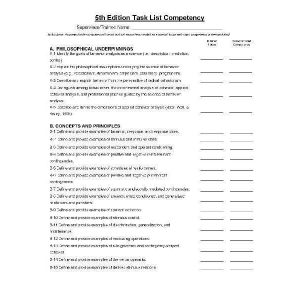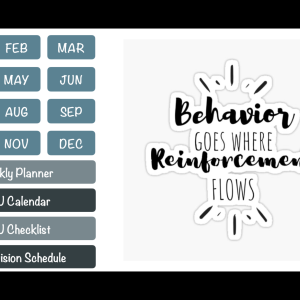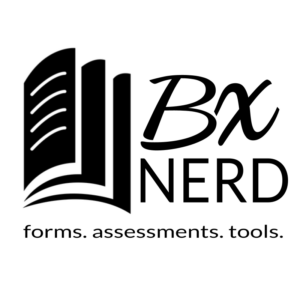Showing 1–16 of 46 results
-

5th Edition Task List Competency Form
Rated 0 out of 5$0.005th Edition Task List Competency Form for supervisor use.
-
Sale!

ABC workbook for caregivers
Rated 0 out of 5$7.99Original price was: $7.99.$5.99Current price is: $5.99.ABC data workbook for caregivers includes the following;
- ABC definition
- ABC examples
- ABC narrative data collection
- ABC structured data collection
-


BATHROOM MANNERS VISUALS Posters Labels Task Box Sequencing Classroom
Rated 0 out of 5$3.00INCLUDED: Visual cues for appropriate bathroom behaviors! Great for classrooms, homes, and clinics! Images include both boy and girl options. Choose & use what you need! Task box cards fit 4″x6″ boxes. Full Page Posters p.4-15, Item Labels p.16-17, Visual Cues p.18-21 Activities: Task Cards p.22-32, Sequencing p. 33-35
-

-

-

BCBA NERD _ Functional Assessment Forms_ “5 + 5 Behavior List”
Rated 0 out of 5$2.00This is a form with which parents, caregivers, and significant others can identify possible target behaviors.
DISCLOSURE STATEMENT: I am not a BCBA nor am I associated with the BACB.
These worksheets were created based on my experience as a behavior specialist and my preparation completing coursework and taking the BCBA exam.
-

Bx Nerd _ Assessing Social Significance of Target Behaviors
Rated 0 out of 5$2.00Use this form during the indirect observation portion of your interview to determine the social significance of a selected target behavior. Some terms on this form, like “habilitation” and “reinforcement,” may make it more appropriate for persons familiar with ABA jargon, like staff and habilitation workers.
DISCLOSURE STATEMENT: I am not a BCBA or associated with the BACB.
These worksheets were created based on my experience as a behavior specialist and my preparation for completing coursework and taking the BCBA exam.
-

Bx Nerd _ Discrete Trial Training Log
Rated 0 out of 5$2.00Use this form to conduct discrete trials with your client.
DISCLOSURE STATEMENT: I am not a BCBA or associated with the BACB.
These worksheets were created based on my experience as a behavior specialist and my preparation for completing coursework and taking the BCBA exam.
-

Bx Nerd _ Free Operant Preference Assessment
Rated 0 out of 5$2.00A free operant preference assessment involves observing duration times a student/child spends while engaged with items in an environment.
Use this form to help discover most-to-least preferred items which can be used as reinforcements in your treatment plan. This form helps clinicians and teachers to assess level and duration of engagement and non engagement.
DISCLOSURE STATEMENT: I am not a BCBA or associated with the BACB.
These worksheets were created based on my experience as a behavior specialist and my preparation for completing coursework and taking the BCBA exam. -

Bx NERD _ Functional Assessment Forms_ “FACTS” _ PART A and PART B
Rated 0 out of 5$3.00A behavior checklist describes specific behaviors and the conditions under which each behavior occurs. Situation – or program-specific checklists can be created to assess one particular behavior or skill area. Using a Likert system within the checklist attempts to more precisely describe and quantity the target behavior of interest by using an ordinal scale.
DISCLOSURE STATEMENT: I am not a BCBA nor am I associated with the BACB.
These worksheets were created based on my experience as a behavior specialist and my preparation completing coursework and taking the BCBA exam. -

Bx Nerd _ Initial Observation and Interview for Dayhab Placement Form
Rated 0 out of 5$4.00This form is a great template for observing and interviewing staff to fill out in regard to behavioral history, treatments and initial observation before the client comes onboard.
DISCLOSURE STATEMENT: I am not a BCBA nor am I associated with the BACB.
These worksheets were created based on my experience as a behavior specialist and my preparation completing coursework and taking the BCBA exam.
-

Bx Nerd _ IOA forms (Total, Exact, Mean, Trial by Trial, Scored & Unscored)
Rated 0 out of 5$5.00Use this form to properly assess the interobserver agreement between two observers. This is a great form to use when training RBTs or direct care workers on logging data accurately. This assesses agreement between observations logged and reported around a specified target behavior.
DISCLOSURE STATEMENT: I am not a BCBA or associated with the BACB.
These worksheets were created based on my experience as a behavior specialist and my preparation for completing coursework and taking the BCBA exam.
-

Bx Nerd _ Paired-Stimulus Preference Assessment
Rated 0 out of 5$2.00Paired- stimulus assessments involve presenting two items to a client/student at the same time and recording which stimulus was approach (or chosen).
Use this form to help discover most-to-least preferred items which can be used as reinforcements in your treatment plan. This form helps clinicians and teachers to assess level and duration of engagement and non engagement.
DISCLOSURE STATEMENT: I am not a BCBA or associated with the BACB.
These worksheets were created based on my experience as a behavior specialist and my preparation for completing coursework and taking the BCBA exam.
-

Bx Nerd _ Procedure Checklist for Discrete Trial BST
Rated 0 out of 5$2.00Use this form as a BCBA supervisor who is evaluating the effectiveness of a discrete trial observation.
DISCLOSURE STATEMENT: I am not a BCBA or associated with the BACB.
These worksheets were created based on my experience as a behavior specialist and my preparation for completing coursework and taking the BCBA exam.
-

Bx Nerd _ Single Stimulus Preference Assessment
Rated 0 out of 5$2.00A single-stimulus preference assessment involves one item at a time to a student/child and marking approach level and duration spent with each item.
Use this form to help discover most-to-least preferred items which can be used as reinforcements in your treatment plan. This form helps clinicians and teachers to assess level and duration of engagement and non engagement.
DISCLOSURE STATEMENT: I am not a BCBA or associated with the BACB.
These worksheets were created based on my experience as a behavior specialist and my preparation for completing coursework and taking the BCBA exam.
-

Bx Nerd _ Treatment Integrity Form
Rated 0 out of 5$2.00These data forms are to evaluate treatment fidelity in terms of opportunities a procedural step is taken and the percentage of the correctness of such opportunities. This is a great form for researchers or trained observers to fill out to be sure the actual procedure matches the one outlined in the method section.
There is also a space for confounding variables to be listed and approaches for control.
DISCLOSURE STATEMENT: I am not a BCBA nor am I associated with the BACB.
These worksheets were created based on my experience as a behavior specialist and my preparation completing coursework and taking the BCBA exam.

